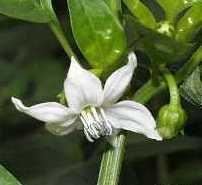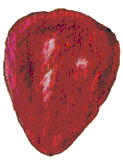|
HORT410 - Vegetable Crops
Peppers - Notes
 Common name: pepper.
Latin name: Capsicum annuum L.
Family: Solanaceae [Solanaceae Images], or nightshade family.
Close relatives used as vegetables: potato, tomato, and eggplant. Capsicum annuum includes the green, bell-shaped, sweet peppers and hot peppers used for spices, including paprika, chili, and cayenne.
Origin: Central and South America; brought back to Europe by Columbus; Spanish and Portugese introduced peppers to other parts of the world, including India and Asia.
Pepper history (TAMU).
Warm season, frost-susceptible. Temperature optimum = 21 and 30 C; night temperatures below 22 C markedly reduces fruit set; temperatures above 32 C cause blossom drop.
Annual, but can grow as a woody biennial in warm climates.
Often started in the greenhouse and then transplanted to the production field.
Dicotyledon.
Flowers are insect pollinated.
Harvested organ: fruit.
Common name: pepper.
Latin name: Capsicum annuum L.
Family: Solanaceae [Solanaceae Images], or nightshade family.
Close relatives used as vegetables: potato, tomato, and eggplant. Capsicum annuum includes the green, bell-shaped, sweet peppers and hot peppers used for spices, including paprika, chili, and cayenne.
Origin: Central and South America; brought back to Europe by Columbus; Spanish and Portugese introduced peppers to other parts of the world, including India and Asia.
Pepper history (TAMU).
Warm season, frost-susceptible. Temperature optimum = 21 and 30 C; night temperatures below 22 C markedly reduces fruit set; temperatures above 32 C cause blossom drop.
Annual, but can grow as a woody biennial in warm climates.
Often started in the greenhouse and then transplanted to the production field.
Dicotyledon.
Flowers are insect pollinated.
Harvested organ: fruit.
 Fruit varies substantially in shape, pericarp thickness, color and pungency.
Most cultivated peppers belong to one of two major groups:
Fruit varies substantially in shape, pericarp thickness, color and pungency.
Most cultivated peppers belong to one of two major groups:
1. the Grossum group includes the globose, mild-flavored, sweet peppers and the pimiento (pimento), or Spanish pepper.
2. the Longum group includes the "hot" chili and cayenne peppers; these have extreme pungency.
The Tabasco pepper, Capsicum frutescens, is a small-fruited hot pepper grown principally for use in commercial hot sauces.
The pungency of hot peppers is caused by the compound, capsaicin.
C. frutescens species may contain as much as 1 percent capsaicin.
Pepper pungency is rated in terms of "Scoville heat units".
Jalapeno and cayenne peppers range from 2,000 to 25,000 units, whereas Tabasco peppers range between 60,000 to 80,000 units.
Bell peppers lack capsaicin and are rated zero on the Scoville heat unit scale of pungency.
Fruit color of peppers changes from mature green to full color (red, yellow, or purple; depending on variety) at maturity.
Generally picked green before full color has developed. However, the Tabasco pepper is usually harvested when red.
Bell peppers for fresh market are typically hand harvested, hydrocooled and stored at 8 to 9 C. Temperatures higher than 12 C accelerate ripening and development of mature fruit color (especially in the presence of ethylene) during storage. Temperatures of less than 7 C are not recommended for storage of mature green peppers - chilling susceptible.
Waxing of peppers often employed to reduce dehydration and bruising during shipping.
Major diseases of pepper in the Midwest:
Major insect pests of pepper in the Midwest:
(see: ID-56: Midwest Vegetable Production Guide for Commercial Growers 2003 - Peppers (PURDUE) [pdf] for information on pepper varieties, spacing, growing transplants, transplanting, fertilizing, and specific pepper disease, weed and insect control recommendations for the Midwest)
   
Sources of information:
Cranshaw, W., Welty, C., Bessin, R. Peppers and eggplant. In "Vegetable Insect Management With Emphasis on the Midwest", (ed. R. Foster, B. Flood), Meister Publishing Co., Willoughby, Ohio, pp. 89-98 (1995).
Nonnecke, I.L. "Vegetable Production", Van Nostrand Reinhold, NY (1989).
Phillips, R., Rix, M. "The Random House Book of Vegetables", Random House, NY (1993).
Maynard, D.N. Pepper. In "The Software Toolworks Multimedia Encyclopedia", Version 1.5, Grolier, Inc. (1992).
Midwest Vegetable Production Guide for Commercial Growers, ID-56, eds. R. Foster, D. Egel, E. Maynard, R. Weinzierl, H. Taber, L.W. Jett, B. Hutchinson, Purdue University Cooperative Extension Service, 2003.
Rajput, J.C., Parulekar, Y.R. Capsicum. In "Handbook of Vegetable Science and Technology: Production, Composition, Storage, and Processing", (ed. D.K. Salunkhe, S.S. Kadam), Marcel Dekker, Inc., NY. pp. 203-224 (1998).
|

